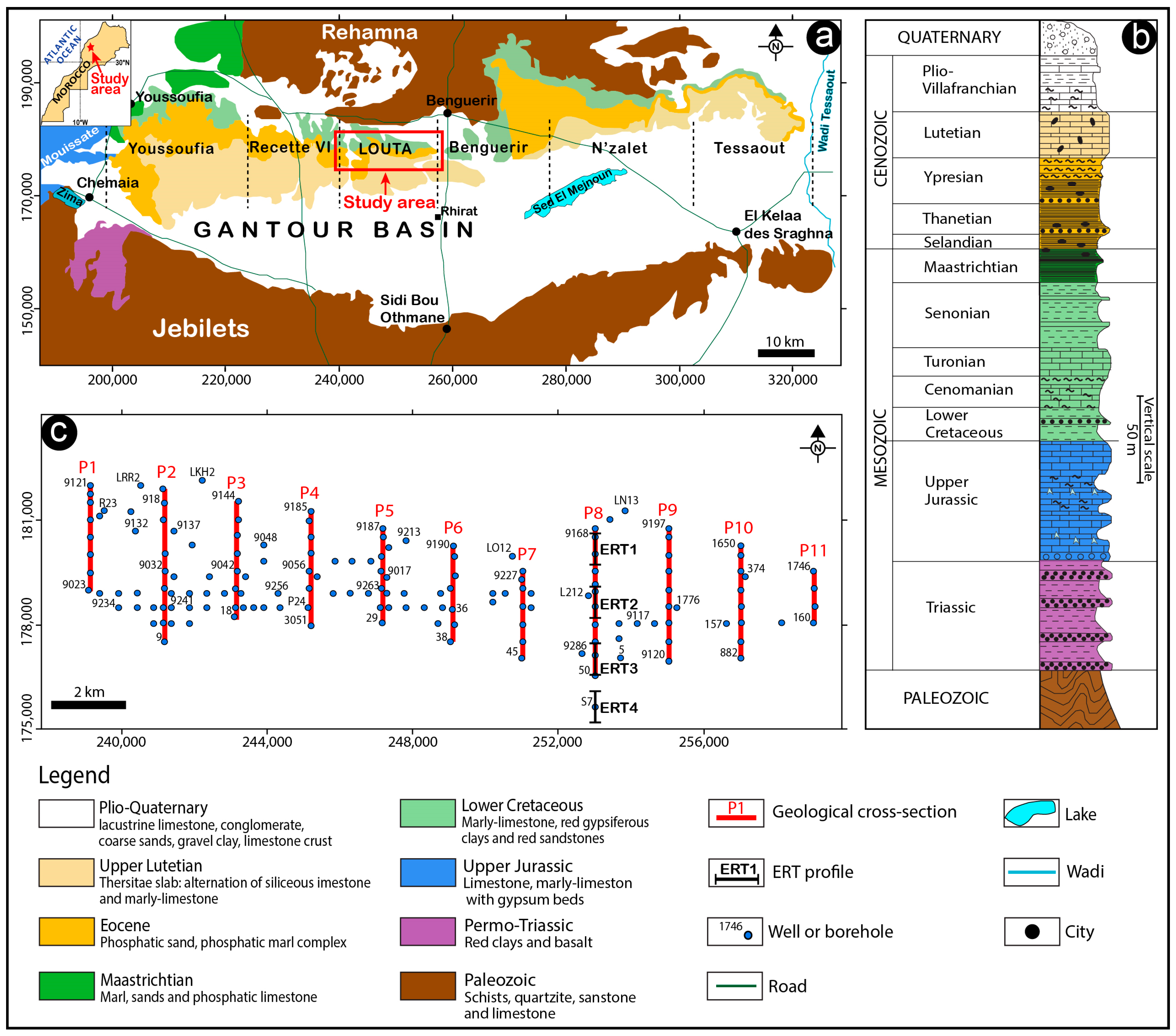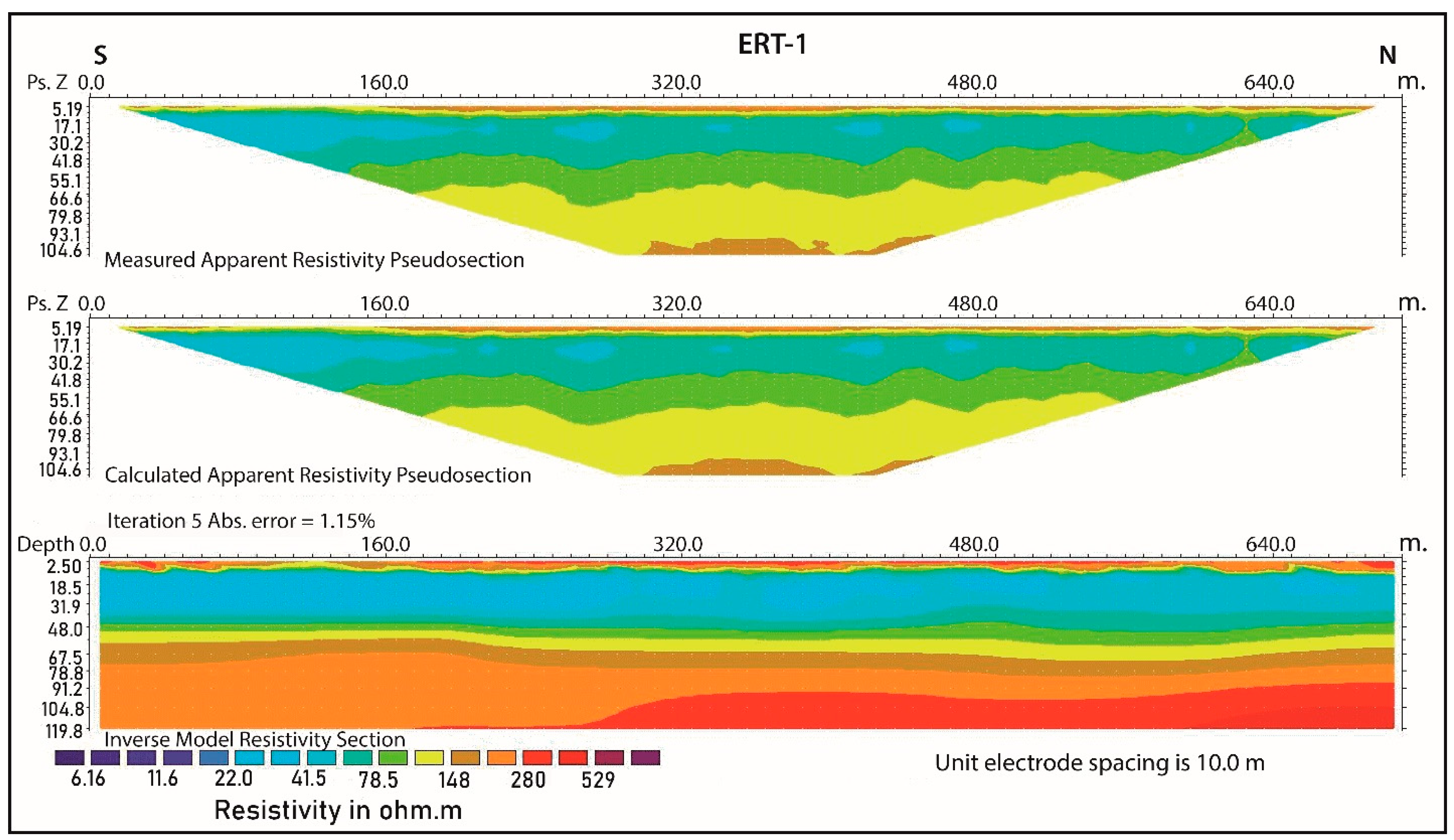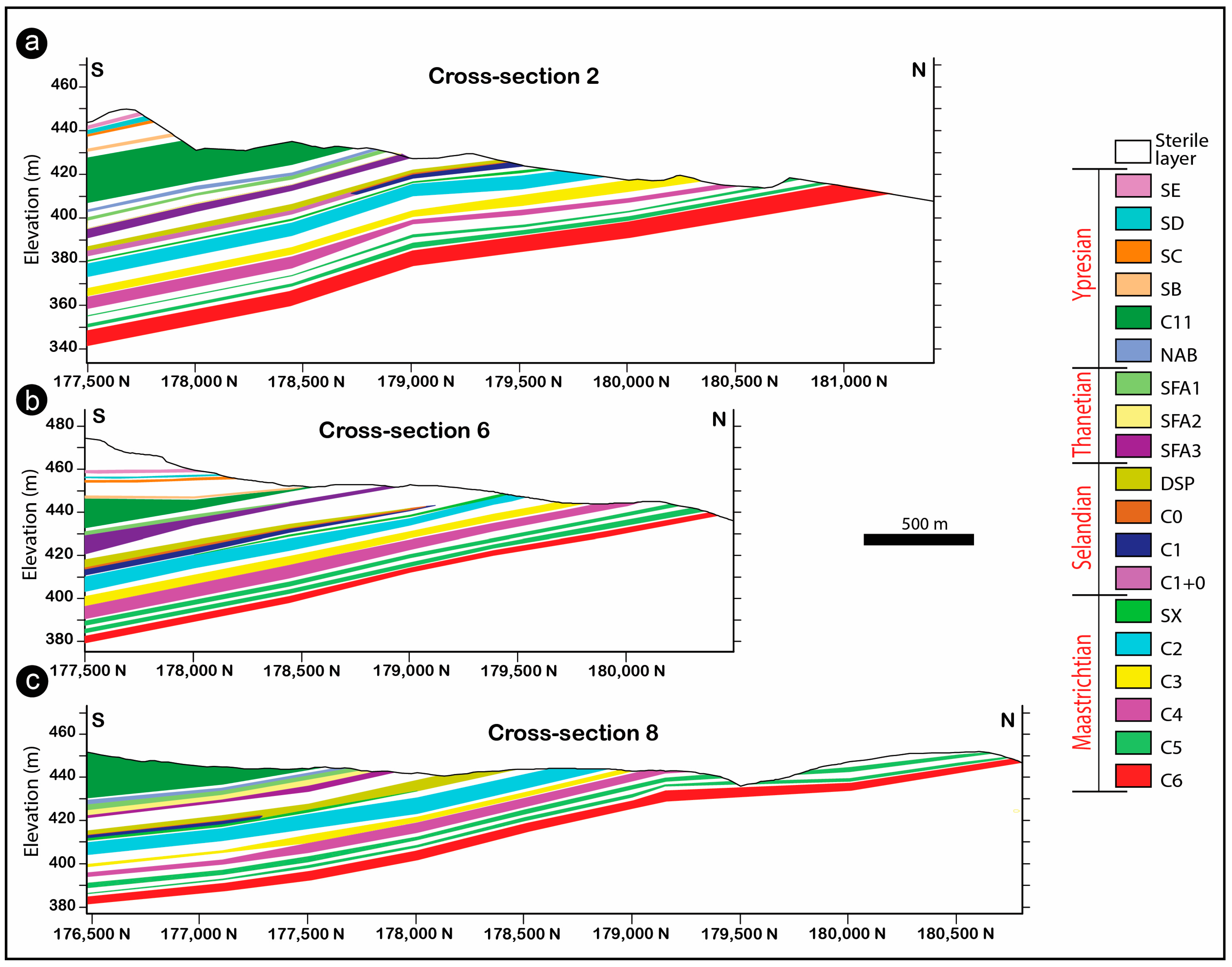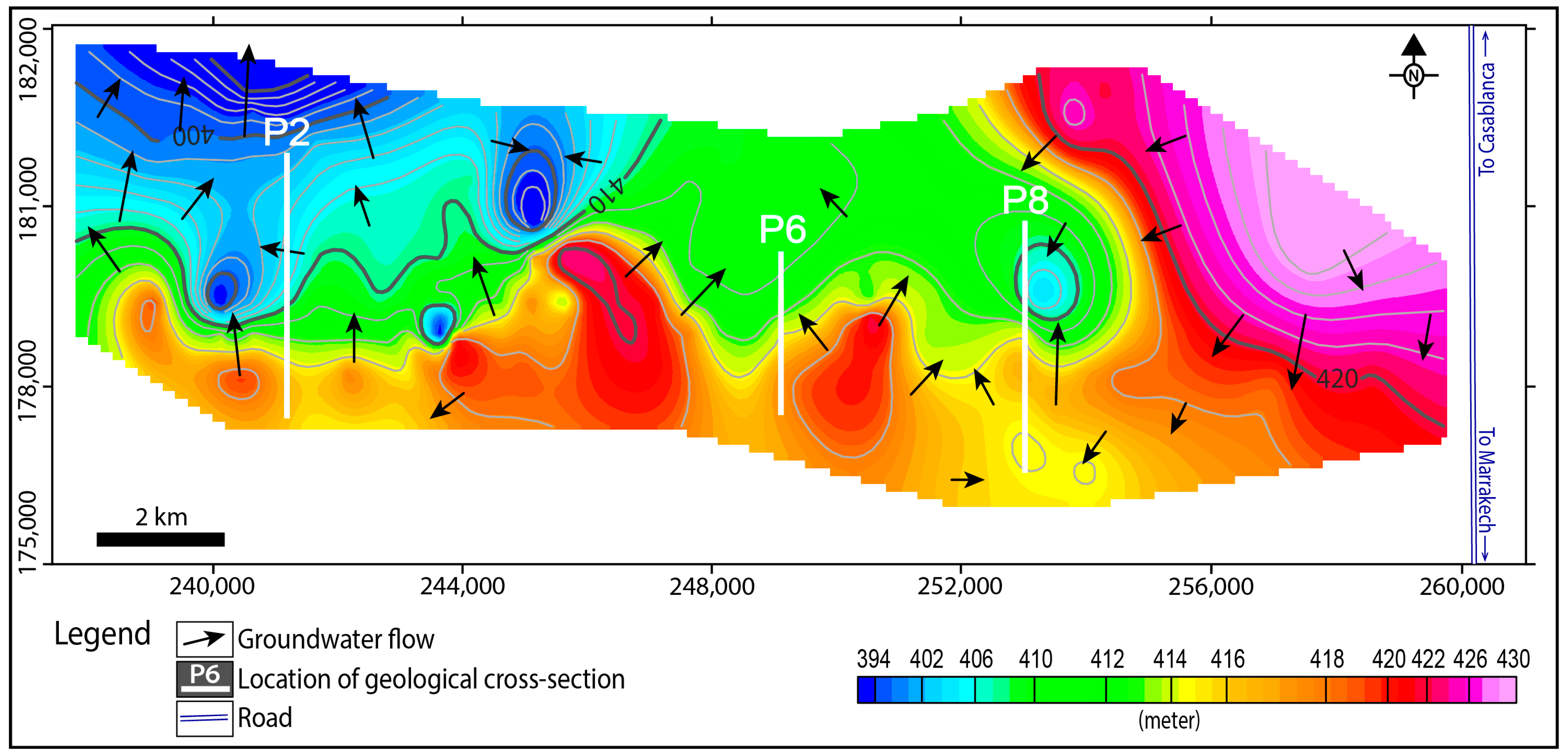New Insights from Geophysical, Hydrogeological and Borehole Data into the Deep Structure of the Louta Phosphatic Deposit (Gantour Basin, Morocco): Mining Implications
Abstract
1. Introduction
2. Geological Setting
3. Material and Methods
3.1. Geological Modeling
3.2. Piezometric Campaign
3.3. ERT Survey
4. Results and Discussion
4.1. Geological Cross-Sections
4.2. Piezometry
4.3. Electrical Resistivity Tomography
5. Conclusions
Author Contributions
Funding
Data Availability Statement
Conflicts of Interest
References
- Choubert, G.; Salvan, H. Evolution du Domaine atlasique marocain depuis les temps paléozoiques. Mém. Serv. Géol. Fr. 1976, 1, 447–527. [Google Scholar]
- Michard, A. Elément de Géologie Marocaine. Notes et Mémoires du Service Géologique du Maroc; Éditions du Service Géologique du Maroc: Rabat, Morocco, 1976. [Google Scholar]
- Zouhri, S.; Kchikach, A.; Saddiqi, O.; Haïmer FZ, E.; Baidder, L.; Michard, A. The Cretaceous-Tertiary Plateaus. In Continental Evolution: The Geology of Morocco; Michard, A., Saddiqi, O., Chalouan, A., de Lamotte, D.F., Eds.; Springer: Berlin/Heidelberg, Germany, 2008; Volume 116, pp. 331–358. [Google Scholar] [CrossRef]
- Boujo, A. Contribution à l’étude géologique du gisement de phosphate Crétacé-Éocène des Ganntour (Maroc Occidental). Université Louis-Pasteur de Strasbourg—Institut de géologie. Sci. Géologiques 1976, 43, 244. [Google Scholar]
- El Kiram, N.; Jaffal, M.; Kchikach, A.; El Azzab, D.; El Ghorfi, M.; Khadiri, O.; Jourani, E.-S.; Manar, A.; Nahim, M. Phosphatic series under Plio-Quaternary cover of Tadla Plain, Morocco: Gravity and seismic data. Comptes Rendus Geosci. 2019, 351, 420–429. [Google Scholar] [CrossRef]
- Kchikach, A.; Elassel, N.; Gurein, R.; Teixido, T.; Pena, J.A.; Jaffal, M. TDEM and EM31 Methods for Detecting Sterile Bodies in the Phosphatic Bearing of Sidi Chennane (Morocco). In Near Surface Geoscience 2012—18th European Meeting of Environmental and Engineering Geophysics; European Association of Geoscientists & Engineers: Bunnik, The Netherlands, 2012. [Google Scholar] [CrossRef]
- Ihbach, F.-Z.; Kchikach, A.; Jaffal, M.; El Azzab, D.; Khadiri Yazami, O.; Jourani, E.-S.; Peña Ruano, J.A.; Olaiz, O.A.; Dávila, L.V. Geophysical Prospecting for Groundwater Resources in Phosphate Deposits (Morocco). Minerals 2020, 10, 842. [Google Scholar] [CrossRef]
- Khalil, N. Contribution à l’étude Hydrogéologique de la Plaine de la Bahira (Maroc Central). Ph.D. Thesis, Université Cadi Ayyad Marrakech, Marrakech, Morocco, 1989. [Google Scholar]
- Er-Rouane, S. Mise en œuvre D’outils Informatisés Pour la Modélisation du Système Aquifère de la Plaine de la Bahira (Maroc occidental). Ph.D. Thesis, Université Cadi Ayyad, Marrakech, Morocco, 1996. [Google Scholar]
- Piqué, A.; Soulaimani, A.; Hoepffner, C.; Bouabdelli, M.; Laville, E.; Amrhar, M.; et Chalouan, A. Géologie du Maroc; GEODE: Marrakech, Morocco, 2007. [Google Scholar]
- Michard, A.; Saddiqi, O.; Chalouan, A.; de Lamotte, D.F. Continental Evolution: The Geology of Morocco: Structure, Stratigraphy, and Tectonics of the Africa-Atlantic-Mediterranean Triple Junction; Springer: Berlin/Heidelberg, Germany, 2008; Volume 116. [Google Scholar]
- Karroum, M. L’apport de la Géophysique et de la Géochimie Dans l’identification Hydrogéologiques et la Qualité des Eaux de la Plaine de la Bahira (Maroc centrale). Ph.D. Thesis, Université Cadi Ayyad, Marrakech, Morocco, 2015. [Google Scholar]
- Bougadra, A. Synthèse Hydrogéologique de la Bahira Occidentale. Ph.D. Thesis, Université Cadi Ayyad, Marrakech, Morocco, 1991. [Google Scholar]
- Bajc, A.F.; Newton, M.J. 3D Modelling of Quaternary Deposits in Waterloo Region, Ontario; A Case Study Using Datamine Studio Software. In Three-Dimensional Geological Mapping for Groundwater Applications: Workshop Extended Abstracts; Geological Survey of Canada: Ottawa, ON, Canada, 2006. [Google Scholar] [CrossRef][Green Version]
- Bye, A.R. The strategic and tactical value of a 3D geotechnical model for mining optimization, Anglo Platinum, Sandsloot open pit. J. S. Afr. Inst. Min. Metall. 2006, 106, 97–104. [Google Scholar]
- Miladinovič, M.; Čebašek, V.; Gojkovič, N. Computer programs for design and modeling in mining. Undergr. Min. Eng. 2011, 19, 109–124. [Google Scholar]
- Sewnun, D.; Joughin, W.; Wanless, M.; Mpunzi, P. The Creation and Application of a Geotechnical Block Model for an Underground Mining Project. In Ground Support 2019: Proceedings of the Ninth International Symposium on Ground Support in Mining and Underground Construction; Hadjigeorgiou, J., Hudyma, M., Eds.; Australian Centre for Geomechanics: Perth, Australia, 2019; pp. 479–492. [Google Scholar] [CrossRef]
- Hu, L.; Zhang, M.; Yang, Z.; Fan, Y.; Li, J.; Wang, H.; Lubale, C. Estimating dewatering in an underground mine by using a 3D finite element model. PLoS ONE 2020, 15, e0239682. [Google Scholar] [CrossRef]
- Safhi, A.M.; Amar, H.; El Berdai, Y.; El Ghorfi, M.; Taha, Y.; Hakkou Yassine Al-Dahhan, M.; Benzaazoua, M. Characterizations and potential recovery pathways of phosphate mines waste rocks. J. Clean. Prod. 2022, 374, 134034. [Google Scholar] [CrossRef]
- Mainoo, P.A.; Manu, E.; Yidana, S.M.; Agyekum, W.A.; Stigter, T.; Duah, A.A.; Preko, K. Application of 2D-Electrical resistivity tomography in delineating groundwater potential zones: Case study from the Voltaian super group of Ghana. J. Afr. Earth Sci. 2019, 160, 103618. [Google Scholar] [CrossRef]
- Mukhwathi, U.; Fourie, F. The influence of angled survey lines on 2D ERT surveys using the Wenner (α) array with implications for groundwater exploration in Karoo rocks. J. Afr. Earth Sci. 2020, 168, 103875. [Google Scholar] [CrossRef]
- Dahlin, T.; Zhou, B. A numerical comparison of 2D resistivity imaging with 10 electrode arrays. Geophys. Prospect. 2004, 52, 379–398. [Google Scholar] [CrossRef]
- Cardarelli, E.; Fischanger, F. 2D data modelling by electrical resistivity tomography for complex subsurface geology. Geophys. Prospect. 2006, 54, 121–133. [Google Scholar] [CrossRef]
- El Assel, N.; Kchikach, A.; Teixidó, T.; Peña, J.; Jaffal, M.; Guérin, R.; Lutz, P.; Jourani, E.-S.; Amaghzaz, M. A Ground Penetrating Radar and Electrical Resistivity Tomography Prospection for Detecting Sterile Bodies in the Phosphatic Bearing of Sidi Chennane (Morocco). Int. J. Geosci. 2011, 2, 406–413. [Google Scholar] [CrossRef]
- Panda, K.P.; Sharma, S.P.; Jha, M.K. Mapping lithological variations in a river basin of West Bengal, India using electrical resistivity survey: Implications for artificial recharge. Environ. Earth Sci. 2018, 77, 626. [Google Scholar] [CrossRef]
- Woźniak, T.; Bania, G. Integrated geoelectrical and geological data sets for shallow structure characterization of the southern margin of the Krzeszowice Graben (Southern Poland). Data Brief 2019, 25, 104157. [Google Scholar] [CrossRef] [PubMed]
- Porras, D.; Carrasco, J.; Carrasco, P.; González, P.J. Imaging extensional fault systems using deep electrical resistivity tomography: A case study of the Baza fault, Betic Cordillera, Spain. J. Appl. Geophys. 2022, 202, 104673. [Google Scholar] [CrossRef]
- Binley, A.; Hubbard, S.S.; Huisman, J.A.; Revil, A.; Robinson, D.A.; Singha, K.; Slater, L.D. The emergence of hydrogeophysics for improved understanding of subsurface processes over multiple scales. Water Resour. Res. 2015, 51, 3837–3866. [Google Scholar] [CrossRef]
- Guérin, R. Borehole and surface-based hydrogeophysics. Hydrogeol. J. 2005, 13, 251–254. [Google Scholar] [CrossRef]
- Gupta, G.; Patil, J.D.; Maiti, S.; Erram, V.C.; Pawar, N.J.; Mahajan, S.H.; Suryawanshi, R.A. Electrical resistivity imaging for aquifer mapping over Chikotra basin, Kolhapur district, Maharashtra. Environ. Earth Sci. 2015, 73, 8125–8143. [Google Scholar] [CrossRef]
- Kumar, D.; Mondal, S.; Warsi, T. Deep insight to the complex aquifer and its characteristics from high resolution electrical resistivity tomography and borehole studies for groundwater exploration and development. J. Earth Syst. Sci. 2020, 129, 68. [Google Scholar] [CrossRef]
- Amponsah, T.Y.; Danuor, S.K.; Wemegah, D.D.; Forson, E.D. Groundwater potential characterisation over the Voltaian basin using geophysical, geological, hydrological and topographical datasets. J. Afr. Earth Sci. 2022, 192, 104558. [Google Scholar] [CrossRef]
- Rochdane, S.; Elgettafi, M.; El Mandour, A.; Himi, M.; Casas, A.; Daafi, Y.; Karroum, M.; Chouikri, I. Contribution of electrical resistivity tomography in the study of aquifer geometry and groundwater salinization of Eastern Haouz and upstream Tassaout domain, Morocco. Environ. Earth Sci. 2022, 81, 122. [Google Scholar] [CrossRef]
- Loke, M.H. RES2DINV Software User’s Manual, Version 3.57; Geotomo Software: Penang, Malaysia, 2007; p. 86. [Google Scholar]
- Loke, M.H.; Dahlin, T. A comparison of the Gauss–Newton and quasi-Newton methods in resistivity imaging inversion. J. Appl. Geophys. 2002, 49, 149–162. [Google Scholar] [CrossRef]
- Jaffal, M.; Charbaoui, A.; Kchikach, A.; El Ghorfi, M.; Khaldoun, A.; El Mahdi Safhi, A.; Bodinier, J.-L.; Yazami, O.K.; Jourani, E.-S.; Manar, A. Gravity study of the Western Bahira Basin and the Gantour Phosphatic Plateau, central Morocco: Interpretation and hydrogeological implications. J. Afr. Earth Sci. 2022, 193, 104581. [Google Scholar] [CrossRef]







Disclaimer/Publisher’s Note: The statements, opinions and data contained in all publications are solely those of the individual author(s) and contributor(s) and not of MDPI and/or the editor(s). MDPI and/or the editor(s) disclaim responsibility for any injury to people or property resulting from any ideas, methods, instructions or products referred to in the content. |
© 2023 by the authors. Licensee MDPI, Basel, Switzerland. This article is an open access article distributed under the terms and conditions of the Creative Commons Attribution (CC BY) license (https://creativecommons.org/licenses/by/4.0/).
Share and Cite
Charbaoui, A.; Kchikach, A.; Jaffal, M.; Khadiri, O.Y.; Guernouche, M.; Amar, M.; Bikarnaf, A.; Jourani, E.-S.; Khelifi, N. New Insights from Geophysical, Hydrogeological and Borehole Data into the Deep Structure of the Louta Phosphatic Deposit (Gantour Basin, Morocco): Mining Implications. Geosciences 2023, 13, 357. https://doi.org/10.3390/geosciences13120357
Charbaoui A, Kchikach A, Jaffal M, Khadiri OY, Guernouche M, Amar M, Bikarnaf A, Jourani E-S, Khelifi N. New Insights from Geophysical, Hydrogeological and Borehole Data into the Deep Structure of the Louta Phosphatic Deposit (Gantour Basin, Morocco): Mining Implications. Geosciences. 2023; 13(12):357. https://doi.org/10.3390/geosciences13120357
Chicago/Turabian StyleCharbaoui, Anas, Azzouz Kchikach, Mohammed Jaffal, Oussama Yazami Khadiri, Mourad Guernouche, Mounir Amar, Ahmed Bikarnaf, Es-Said Jourani, and Nabil Khelifi. 2023. "New Insights from Geophysical, Hydrogeological and Borehole Data into the Deep Structure of the Louta Phosphatic Deposit (Gantour Basin, Morocco): Mining Implications" Geosciences 13, no. 12: 357. https://doi.org/10.3390/geosciences13120357
APA StyleCharbaoui, A., Kchikach, A., Jaffal, M., Khadiri, O. Y., Guernouche, M., Amar, M., Bikarnaf, A., Jourani, E.-S., & Khelifi, N. (2023). New Insights from Geophysical, Hydrogeological and Borehole Data into the Deep Structure of the Louta Phosphatic Deposit (Gantour Basin, Morocco): Mining Implications. Geosciences, 13(12), 357. https://doi.org/10.3390/geosciences13120357





